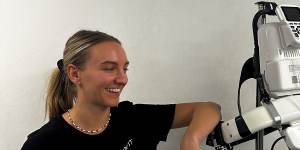
Exercise physiologist Anna Minchin says advances in robotics are helping more and more people achieve their goals and get mobile.Supplied
8:45am:As soon as I arrive at the clinic I look at the schedule to see which clients are coming in so I can set up the Hybrid Assistive Limb (HAL) exoskeletons for the day. The exoskeleton is a wearable,neuro-controlled device used in therapy. We fit the client into it,and it can assist with walking goals or walking rehabilitation.
The set-up includes adjusting limb lengths,shoe sizes,placing the battery units in and connecting the iPad. Currently,we have two students who are completing discipline-specific placements,so I discuss the client sessions for the day and which clinical skills we will be covering.
9am:My first client is an initial consultation with a 12-year-old girl who has spastic quadriplegic cerebral palsy and is wheelchair-dependent. Her goal is to walk with a support frame,so she’ll be working with us in intensive blocks.
The technology[for the robot] took us 10 years to get to Australia. It is quite amazing. It’s neuro-controlled,so we put electrodes on the limb,and then we can see any muscular activity in real time.
The electrodes don’t stimulate,they just pick up muscle activity. The progress we see is just so much more efficient than regular therapy because we can see any kind of deficit straight away via the iPad,or adjust it to make movement easier.
“His goal is to walk down the aisle,and he’s not going to have his wedding until he can do it.”
11am:My second client is a 35-year-old male C4/5 quadriplegic. He has come in for a two-hour exoskeleton session where he will complete approximately 30 minutes of treadmill walking. We begin with warm-up exercises for his abdominals and trunk extensor muscles–and then attach the electrodes,harness and fit him into the exoskeleton. It’s all individualised.
The client is also in a body weight support frame,so there’s no chance of falling. We have different shoe sizes and different limb lengths,so it’s as comfortable as possible.
1:30pm:My third client is a 61-year-old male who suffered a stroke and is right-side affected. He is doing two sessions a week with me,and today we are using the single-joint exoskeleton on his affected elbow to encourage voluntary elbow flexion and extension. His goal is to walk down the aisle,and he’s not going to have his wedding until he can do it.
We actually had a client do their wedding in our Brisbane clinic on Valentine’s Day. She just wanted to stand for her vows;it was pretty special.
I really want people with neurological conditions to know that there is technology out there to help them.[Especially those who] think that perhaps they don’t have any hope of progressing,or don’t think they’re going to get any better with their physicality and functional capacity.
If you can stand and go to the bathroom independently when you couldn’t before,that’s going to change your life.
3:00pm:My last client is a 45-year-old female who has multiple sclerosis. She comes in weekly for a strength and conditioning session,without any technology used.
We tailor the sessions based on the client’s goals:hers are to maintain her current functional capacity,improve her walking and trunk stability. A lot of our MS clients’ sessions are targeted at prevention,to prevent the deconditioning that comes if someone stops moving altogether.
4:30pm:For the last half hour of the day,I complete my notes for each session,debrief with the students and pack down the exoskeletons. Everyone has different shoe sizes and limb lengths,and it’s all battery operated,so there are a million different things to charge.
The Business Briefing newsletter delivers major stories,exclusive coverage and expert opinion..